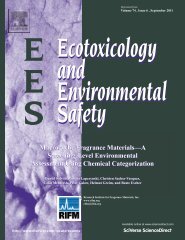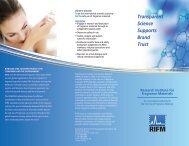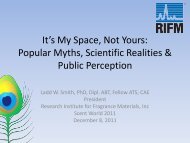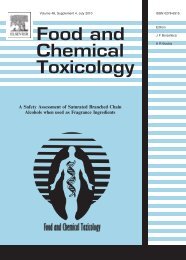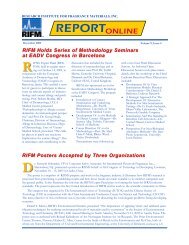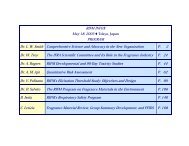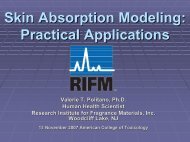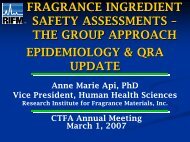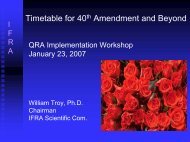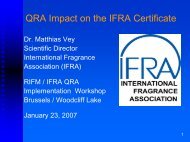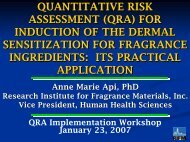Read more - Research Institute for Fragrance Materials
Read more - Research Institute for Fragrance Materials
Read more - Research Institute for Fragrance Materials
You also want an ePaper? Increase the reach of your titles
YUMPU automatically turns print PDFs into web optimized ePapers that Google loves.
Inhalation<br />
Toxicology<br />
International Forum <strong>for</strong><br />
Respiratory <strong>Research</strong><br />
Reprinted from<br />
Inhal Toxicol 2012 24(01-04):182–193<br />
A Lung Dosimetry Model of Vapor Uptake and Tissue<br />
Disposition<br />
Dr. Bahman Asgharian, Owen T. Price, Dr. Jeffry D Schroeter,<br />
Dr. Julia Kimbell, Dr. Madhuri Singal<br />
<strong>Research</strong> <strong>Institute</strong> <strong>for</strong><br />
<strong>Fragrance</strong> <strong>Materials</strong><br />
www.rifm.org<br />
rifm@rifm.org
Inhalation Toxicology, 2012; 24(1-4): 182–193<br />
© 2012 In<strong>for</strong>ma Healthcare USA, Inc.<br />
ISSN 0895-8378 print/ISSN 1091-7691 online<br />
DOI: 10.3109/08958378.2012.654857<br />
RESEARCH ARTICLE<br />
A lung dosimetry model of vapor uptake and tissue disposition<br />
B. Asgharian 1 , O. T. Price 1 , J. D. Schroeter 1 , J. S. Kimbell 2 , and M. Singal 3<br />
1<br />
Applied <strong>Research</strong> Associates, Inc., Security Engineering & Applied Sciences, Raleigh, NC, USA, 2 Department of<br />
Otolaryngology/Head and Neck Surgery, University of North Carolina, Chapel Hill, NC, USA, and<br />
3<br />
<strong>Research</strong> <strong>Institute</strong> <strong>for</strong> <strong>Fragrance</strong> <strong>Materials</strong>, Inc., Woodcliff Lake, NJ, USA<br />
Abstract<br />
Inhaled vapors may be absorbed at the alveolar-capillary membrane and enter arterial blood flow to be carried to<br />
other organs of the body. Thus, the biological effects of inhaled vapors depend on vapor uptake in the lung and<br />
distribution to the rest of the body. A mechanistic model of vapor uptake in the human lung and surrounding tissues<br />
was developed <strong>for</strong> soluble and reactive vapors during a single breath. Lung uptake and tissue disposition of inhaled<br />
<strong>for</strong>maldehyde, acrolein, and acetaldehyde were simulated <strong>for</strong> different solubilities and reactivities. Formaldehyde,<br />
a highly reactive and soluble vapor, was estimated to be taken up by the tissues in the upper tracheobronchial<br />
airways with shallow penetration into the lung. Vapors with moderate solubility such as acrolein and acetaldehyde<br />
were estimated to penetrate deeper into the lung, reaching the alveolar region where absorbed vapors had a much<br />
higher probability of passing through the thin alveolar-capillary membrane to reach the blood. For all vapors,<br />
tissue concentration reached its maximum at the end of inhalation at the air-tissue interface. The depth of peak<br />
concentration moved within the tissue layer due to vapor desorption during exhalation. The proposed vapor uptake<br />
model offers a mechanistic approach <strong>for</strong> calculations of lung vapor uptake, air:tissue flux, and tissue concentration<br />
profiles within the respiratory tract that can be correlated to local biological response in the lung. In addition, the<br />
uptake model provides the necessary input <strong>for</strong> pharmacokinetic models of inhaled chemicals in the body, thus<br />
reducing the need <strong>for</strong> estimating requisite parameters.<br />
Keywords: Lung vapor uptake modeling, tissue dosimetry modeling, tissue uptake<br />
Introduction<br />
Calculations of vapor uptake by airways of the respiratory<br />
tract are paramount to study dose-dependent local<br />
effects and, in addition, systemic effects that may result<br />
from transport and disposition to other organs and tissues<br />
of the body. The lung dose of inhaled vapors provides<br />
the link between exposure concentration and<br />
biological response. Previous vapor dosimetry modeling<br />
ef<strong>for</strong>ts examined lung vapor uptake based on compartmental<br />
approaches (e.g. Haggard, 1924; Johanson, 1990;<br />
Kumagai & Matsunaga, 2000; Gloede et al., 2011; to name<br />
a few). Mechanistic models were also developed to<br />
study vapor uptake patterns and dose in the respiratory<br />
tract. Early mechanistic models examined vapor mixing,<br />
regional vapor concentration stratification and inhomogeneity<br />
in order to gain insight into airway function and<br />
structure. La Force and Lewis (1970) developed a mechanistic<br />
model to calculate the inhaled concentration of<br />
inert gases in the lung by numerically solving the diffusion<br />
equation. However, the simultaneous processes<br />
of convection and diffusion were not considered in the<br />
study. Consequently, Cumming et al. (1971), Scherer et al.<br />
(1972), Chang and Farhi (1973), and Paiva (1972, 1973)<br />
solved the convective-diffusion equation in the Weibel<br />
(1973) symmetric lung geometry to find air-phase vapor<br />
concentration throughout the pulmonary air space.<br />
The primary objective of these studies was to evaluate<br />
concentration stratification and its contribution to the<br />
slope of the alveolar plateau. Other investigators studied<br />
the effect of airway geometry based on the washout of<br />
inhaled inert gases, such as N 2<br />
, H 2<br />
, and SF 6<br />
, to examine<br />
lung structural changes (e.g. Baker et al., 1974; Paiva et al.,<br />
Address <strong>for</strong> Correspondence: Dr. Bahman Asgharian, Applied <strong>Research</strong> Associates, Security Engineering & Applied Sciences, 8537 Six Forks<br />
Road, Raleigh, NC 27615, USA. E-mail: basgharian@ara.com<br />
(Received 13 October 2011; revised 05 December 2011; accepted 03 January 2012)<br />
182
183 B. Asgharian et al.<br />
1976; Verbanck & Paiva, 1990). Additional improvements<br />
to modeling <strong>for</strong>mulation and predictions were made by<br />
Pack et al. (1977) and Davidson (1981).<br />
The above studies mainly considered inert gases <strong>for</strong><br />
which there was minimal absorption into lung tissues.<br />
Soluble vapors inhaled into the lung are absorbed by<br />
lung tissues at the air:tissue interface, where they subsequently<br />
diffuse throughout the tissue layer and may be<br />
metabolized or react with tissue constituents. Metabolism<br />
and reaction of the vapor within the tissue may result in<br />
dose-dependent tissue damage. Lung uptake of vapors<br />
that people are exposed to, either environmentally or<br />
occupationally (e.g. ozone, chlorine, and <strong>for</strong>maldehyde),<br />
has been investigated in several studies. A model of ozone<br />
uptake in the lung was proposed by McJilton et al. (1972).<br />
However, since ozone reaction in the mucus layer was not<br />
considered, the model was <strong>more</strong> predictive of the dosimetry<br />
of non-reactive gases. By adding chemical reaction in<br />
the mucus layer, Miller et al. (1978) modified the model<br />
to calculate ozone uptake in the lungs of guinea pigs, rabbits,<br />
and humans. The model was further extended by<br />
including tissue and blood compartments (Miller et al.,<br />
1985). Additionally, uptake of ozone in the lungs of<br />
children was investigated by using child-specific lung<br />
and breathing in<strong>for</strong>mation (Overton & Graham, 1989).<br />
Overton et al. (1987) investigated the uptake of ozone in<br />
rats with symmetric lung geometries. The vapor uptake<br />
model in rats was extended to asymmetric lung geometries<br />
(Overton & Graham, 1995) <strong>for</strong> <strong>more</strong> detailed dose<br />
assessment. Bush et al. (1996, 2001) computed the uptake<br />
of ozone and chlorine in human lungs. Their predictions<br />
matched in vivo uptake measurements <strong>for</strong> ozone inhalation<br />
<strong>for</strong> different lung distal penetrations. Based on the<br />
same transport model developed earlier <strong>for</strong> ozone vapor<br />
uptake predictions, Overton et al. (2001) also constructed<br />
a lung dosimetry model to predict uptake of inhaled<br />
<strong>for</strong>maldehyde in the human respiratory tract. The model<br />
is useful <strong>for</strong> evaluating uptake of highly soluble and reactive<br />
vapors (Overton, 2001).<br />
The a<strong>for</strong>ementioned models were applicable only to<br />
vapors with first-order reaction rates in the tissue. While<br />
capable of predicting airway uptake and wall fluxes, these<br />
studies did not calculate tissue concentrations, which are<br />
needed to relate model predictions to effects observed<br />
in vivo, to study tissue damage and health risk impact.<br />
Thus, the models could not predict the systemic dose,<br />
from inhaled vapors, that was available to other organs of<br />
the body. For health risk assessment due to vapor exposure,<br />
tissue susceptibility in these studies was correlated<br />
to vapor flux to airway walls. However, the relationship<br />
between wall fluxes and tissue concentrations are not<br />
known and may not necessarily correlate proportionally.<br />
Additional studies are required to investigate the<br />
subsequent tissue concentration profiles while including<br />
metabolism and reaction of the vapor in the tissue by<br />
various pathways.<br />
Accurate assessment of vapor uptake, and tissue disposition,<br />
in the lung must include vapor transport by<br />
<br />
diffusion in the tissue as well as vapor metabolism and<br />
reaction within the tissue. Since the transport of inhaled<br />
vapors into the lung tissues depends on the concentration<br />
of the vapor in the tissue, vapor transport equations<br />
in the air and tissue phases are coupled and must<br />
be solved simultaneously. Models of coupled air-tissue<br />
transport in the lung have already been developed <strong>for</strong><br />
non-reactive vapors (Tsu et al., 1988; George et al., 1993).<br />
In this study, an air-tissue vapor transport model during<br />
a single breathing cycle is described that can simulate<br />
a wide range of vapor solubilities and tissue reactivities.<br />
Vapor transport in the airway lumen was considered as a<br />
conductive and diffusive process. Vapors that were taken<br />
up by the surrounding airway tissues would be metabolized<br />
and react with the tissue by first-order and saturable<br />
clearance pathways while undergoing diffusive transport<br />
across the tissue layer to reach the arterial blood. A coupling<br />
of the air-tissue transport equations was <strong>for</strong>mulated<br />
using an overall mass transfer coefficient <strong>for</strong> vapor<br />
transport across air and tissue phases. Lung uptake and<br />
tissue disposition was simulated <strong>for</strong> <strong>for</strong>maldehyde, acrolein,<br />
and acetaldehyde, as representative soluble, reactive<br />
vapors.<br />
<strong>Materials</strong> and methods<br />
To determine uptake of inhaled vapors in the airways,<br />
airflow distribution and vapor concentration must<br />
be determined airway-by-airway through solving the<br />
momentum balance (Navier-Stokes) and mass balance<br />
(convective-diffusion) equations <strong>for</strong> the inhaled air and<br />
vapor, respectively. However, intra- and inter-subject<br />
variability in airway shape, the large number of airways,<br />
and multi-scale dimensions of the airways pose a challenge<br />
to solving the complete sets of transport equations.<br />
To <strong>for</strong>mulate a predictive model of regional and local<br />
uptake of inhaled materials, each lung airway is assumed<br />
to be cylindrically shaped with a uni<strong>for</strong>m tissue thickness<br />
within the airway. However, tissue thickness decreases<br />
distally in the lung with airway generation number. Since<br />
the airflow Reynolds number in the lung drops below<br />
unity just after a few airway generations, the airflow<br />
velocity profile is assumed to be uni<strong>for</strong>m with average<br />
parabolic velocity. In addition, because of steady and<br />
slow decrease, airway concentration is assumed to vary<br />
only with lung distal penetration. Consequently, the convective-diffusion<br />
transport equation of the inhaled vapor<br />
in an airway can be described by the following equation:<br />
−C<br />
−t<br />
a<br />
− −<br />
U C 2<br />
a<br />
Ca<br />
2<br />
+ = D<br />
−z<br />
−z<br />
R J<br />
a<br />
−<br />
2<br />
R<br />
(1)<br />
Where, C a<br />
is the vapor concentration in the air phase,<br />
t is the elapsed time, U is the average air velocity in<br />
the airway, z is the axial direction, D a<br />
is the vapor diffusion<br />
coefficient in air, R is the airway radius, and J R<br />
is the radial flux of vapor at the air-tissue interface<br />
(Miller et al., 1985). Since vapor transport occurs only<br />
Inhalation Toxicology
Vapor uptake modeling in the lung 184<br />
in the axial (z) direction, the flux (sink) term in equation<br />
(1) replaces wall boundary conditions. Equation<br />
(1) must be solved <strong>for</strong> each airway in the lung with<br />
appropriate initial conditions and inlet and outlet<br />
boundary conditions to find vapor concentrations<br />
at various locations within the lung. Unlike particles<br />
that are removed from the air stream once they come<br />
into contact with airway walls, vapor losses depend<br />
on their interaction with tissue constituents. Thus,<br />
air and tissue phase transport processes are coupled<br />
and, in principle, must be solved simultaneously.<br />
However, the two-way dependency can be reduced<br />
to a one-way, vapor-to-tissue coupling to allow the<br />
solution of the uncoupled equation (1) <strong>for</strong> vapor<br />
concentration in the air, if the radial diffusion flux<br />
of the vapor is equal to the vapor concentration at<br />
the air-tissue interface times a constant coefficient,<br />
referred to as the overall mass transfer coefficient<br />
(K o<br />
). Asgharian et al. (2011) derived analytical expressions<br />
<strong>for</strong> the overall mass transfer coefficients during<br />
inhalation, pause, and exhalation time intervals during<br />
the breathing cycle. By substituting <strong>for</strong> the overall<br />
mass transfer coefficient in the flux, J R<br />
, equation (1)<br />
became:<br />
Where,<br />
−C<br />
−t<br />
− −<br />
U C 2<br />
D<br />
C 2K<br />
+ = −<br />
−z<br />
−z<br />
R C (2)<br />
2<br />
a<br />
a a a o<br />
C<br />
a<br />
K<br />
= Ca<br />
+ 1 (3)<br />
K1 In which, K t<br />
is the tissue-phase mass transfer coefficient<br />
and coefficient K i<br />
arose due to unsteady transport<br />
of vapor across the air- tissue interface. Expressions <strong>for</strong> K t<br />
and K i<br />
are given by Asgharian et al. (2011) as a function<br />
of vapor physico-chemical properties and airway dimensions.<br />
The overall mass transfer coefficient K o<br />
during<br />
each breathing time was given by:<br />
1 1 1<br />
= + (4)<br />
Ko<br />
Kg<br />
K 1<br />
In which, K g<br />
is the air-phase mass transfer coefficient<br />
(Bush et al., 2001). Vapor flux across the air-tissue interface<br />
was given by the product of the mass transfer coefficient<br />
and vapor concentration at the air-tissue interface<br />
(Asgharian et al., 2011). By network analogy, the overall<br />
mass transfer coefficient can be represented by an overall<br />
resistance of two resistances in parallel: air-phase resistance<br />
(K g<br />
) and tissue resistance (K t<br />
). The relative values of<br />
air and tissue resistances signify the contribution of each<br />
phase to vapor uptake.<br />
The solution of equation (2) follows from the solution<br />
of nanoparticle deposition (Asgharian & Price, 2007),<br />
replacing nanoparticle fluxw losses with ( 2Ko/ R)<br />
× C <strong>for</strong><br />
a<br />
inhalation and exhalation. Further details can be found<br />
in Asgharian and Price (2007). Vapor losses in an airway<br />
during pause are governed by the diffusion equation<br />
2<br />
−Ca<br />
− Ca 2K<br />
o<br />
= D<br />
−t<br />
−z<br />
R C<br />
a<br />
− (5)<br />
2<br />
a<br />
Assuming a linear variation of concentration along<br />
airway length and no exchange of vapor between parent<br />
or daughter branches during pause (i.e. zero concentration<br />
at the ends of the airway), equation (5) may be<br />
solved to give:<br />
Where,<br />
−2Ko<br />
t<br />
R<br />
2[ Cp<br />
−Cd]<br />
e<br />
Ca( zt , ) =<br />
L<br />
`<br />
n<br />
2 [ Cp<br />
−( −1) Cd<br />
] e<br />
+<br />
p ∑<br />
n<br />
g<br />
n=<br />
1<br />
2<br />
n<br />
2ko<br />
n<br />
= +<br />
R<br />
2<br />
−rt<br />
n<br />
<br />
⎛ npz⎞<br />
sin⎜<br />
⎟<br />
⎝ L ⎠<br />
(6)<br />
p D a<br />
(7)<br />
2<br />
L<br />
2 2<br />
In which, C p<br />
and C d<br />
correspond to vapor concentrations<br />
at the proximal and distal ends of the airway at<br />
the beginning of the pause, and L is the airway length.<br />
Uptake fraction is the fraction of inhaled vapor that is<br />
cleared from the air, in an airway or region of the lung,<br />
during a complete breathing cycle. Vapor uptake fraction<br />
(UP) in an airway during inhalation, pause, or exhalation<br />
time interval is found from:<br />
T L<br />
2p<br />
R<br />
UP = kCdzdt<br />
CV<br />
∫∫<br />
0 a (8)<br />
0 ti<br />
0 0<br />
Where, C 0<br />
is the inhaled (exposure) concentration of<br />
vapor, V t i<br />
is the inhaled volume of air during one breath,<br />
or tidal volume, and T is inhalation, pause, or exhalation<br />
time interval.<br />
Vapor concentration in the lung tissues of an airway<br />
during any given breathing interval can be found by<br />
solving the reaction-diffusion equation (Schroeter et al.,<br />
2006):<br />
2<br />
−C<br />
−<br />
− + D<br />
C t<br />
t<br />
( Vmax/ Vt)<br />
Ct<br />
t<br />
= KC<br />
f t<br />
+<br />
2<br />
−t<br />
−r<br />
Km<br />
+ Ct<br />
<br />
Where, C t<br />
is the vapor concentration in the tissue, D t<br />
is the vapor diffusion coefficient in the tissue layer, K f<br />
is<br />
a first-order rate constant, V t<br />
is the lung tissue volume,<br />
r is the tissue depth, and V max<br />
and K m<br />
are Michaelis–<br />
Menten rate constants. According to equation (9), the<br />
transport of vapor through the tissue occurs by radial<br />
diffusion and is cleared by first-order and saturable<br />
pathways. When warranted, expression (9) may be<br />
extended to vapors of multiple saturable pathways<br />
(e.g. high-capacity, low-affinity and low-capacity, highaffinity<br />
pathways) and can also include additional<br />
first-order clearance terms.<br />
(9)<br />
© 2012 In<strong>for</strong>ma Healthcare USA, Inc.
185 B. Asgharian et al.<br />
Once air-phase concentration is determined during<br />
each time interval of the breathing cycle, the parabolic<br />
partial differential equation (9) is subsequently solved<br />
using an implicit finite-difference method (Asgharian<br />
et al., 2011) to find vapor concentration and elimination<br />
in the tissue walls of each airway. Tissue initial and<br />
boundary conditions must also be specified to allow the<br />
solution of equation (9). During inhalation, initial vapor<br />
concentration in the tissue is zero when modeling a single<br />
breath exposure. In addition, vapor concentration in<br />
the air (C a<br />
) is constant (Yu, 1978). Vapor concentration at<br />
the air-tissue interface (C a:t<br />
) is given by (Asgharian et al.,<br />
2011):<br />
<br />
C<br />
a:t<br />
kg<br />
k k C ki<br />
=<br />
a<br />
− (10)<br />
+ k + k<br />
g<br />
Tissue concentration at the other end of the tissue<br />
layer (tissue-blood interface) is assumed to be zero to<br />
simulate complete clearance from the tissue due to blood<br />
perfusion. During pause and exhalation, initial tissue<br />
concentration is already determined from the solution<br />
of equation (9) at the end of the previous breathing time<br />
interval. Tissue concentration at the air-tissue interface is<br />
also found from equation (10). However, vapor concentration<br />
in the air, and thus at the air-tissue interface (equation<br />
10), varies over time during pause and exhalation.<br />
It should be noted that vapor concentration at the other<br />
end of the tissue layer, where vapor is transported to the<br />
blood flow, is assumed to be zero at the interface to allow<br />
<strong>for</strong> the highest transfer of vapor to the blood and other<br />
organs of the body and does not imply a concentration<br />
of zero entering the blood. This scenario corresponds to<br />
the most conservative (highest) estimate of whole body<br />
burden and is particularly useful in risk analysis from<br />
exposure to inhaled compounds. However, this assumption<br />
could affect regional dosimetry estimates, especially<br />
<strong>for</strong> vapors that penetrate to the deep lung since uptake in<br />
the pulmonary region depends on the amount of vapor<br />
absorbed in the upper airways.<br />
Since tissue concentration at the start of inhalation<br />
is zero, vapor transfer always occurs from air to tissue,<br />
down the concentration gradient. During exhalation,<br />
however, the tissue concentration may be higher than<br />
that in the airway with the possibility of tissue off-gassing,<br />
or desorption of vapor, which may result in a decrease in<br />
tissue concentration, and increase in airway concentration,<br />
of vapor. The transient coefficient K i<br />
in equation (10)<br />
accounts <strong>for</strong> unsteady and bi-directional transport of<br />
vapor across the air-tissue interface. While bi-directional<br />
transport of vapor across the tissue layer is often present<br />
<strong>for</strong> most chemicals, it has so far not been accounted <strong>for</strong> in<br />
the calculations of mass transfer coefficient.<br />
A vapor uptake dosimetry model was developed based<br />
on equations (2) and (9) that allows <strong>for</strong> calculations of<br />
inhaled vapor in all airways of the lung and surrounding<br />
tissues during a complete breathing cycle that consists<br />
t<br />
g<br />
t<br />
of inhalation, pause, and exhalation. The model solves<br />
equations (2) and (9) numerically and runs on a personal<br />
computer within a few minutes depending on the lung<br />
distal penetration of the selected vapor.<br />
Results and discussion<br />
The vapor uptake model described in the above section<br />
was used to predict uptake fractions of inhaled soluble,<br />
reactive vapors in the human lung. Uptake fraction was<br />
subsequently used to find the wall flux of vapors in each<br />
airway. The wall flux is the product of uptake fraction,<br />
exposure concentration, tidal volume, and breathing<br />
frequency divided by the surface area of the airway. In<br />
addition, vapor concentration in the lumen of an airway<br />
was used as an inlet boundary condition to calculate<br />
the concentration of the compound in the tissue of each<br />
airway. Unless otherwise specified, computations were<br />
per<strong>for</strong>med at an exposure concentration of 1 mg/m 3 , a<br />
minute ventilation of 7.5 L/min, and a breathing cycle of<br />
5 s with 2.5 s inhalation, 0.2 s pause, and 2.3 s exhalation<br />
(ICRP, 1994). Calculations were per<strong>for</strong>med <strong>for</strong> a single<br />
breath. For multiple breaths, tissue concentration may<br />
remain nonzero at the end of exhalation and accumulate<br />
with repeated breathing. In<strong>for</strong>mation on the diffusion<br />
coefficients of compounds in the lung tissues is not available.<br />
A diffusion coefficient value of 10 −6 cm 2 /s, which is<br />
approximately an order of magnitude smaller than that<br />
in water, was used in the calculations to account <strong>for</strong> the<br />
increased viscosity observed in lung tissues (Bush et al.,<br />
1998; Pryor, 1992). The sensitivity of the tissue diffusion<br />
coefficient was analysed by increasing the value<br />
by an order of magnitude. This resulted in about a 10%<br />
decrease in lung tissue uptake. All predictions were<br />
made <strong>for</strong> the case of endotracheal breathing (no head).<br />
When comparing predictions with those of other studies<br />
or reported measurements, the data were corrected <strong>for</strong><br />
head uptakes.<br />
Model validation<br />
Model predictions were first compared with available<br />
in<strong>for</strong>mation in the literature. First, a comparison was<br />
made with another previous modeling ef<strong>for</strong>t <strong>for</strong> support<br />
of our predictions. Overton et al. (2001) solved equation<br />
(1) numerically to find vapor concentration in the<br />
airway lumen and wall mass flux of <strong>for</strong>maldehyde to airway<br />
walls via oral breathing using a Weibel (1963) lung<br />
geometry. Since <strong>for</strong>maldehyde is highly soluble, vapor<br />
is quickly absorbed by the walls on contact. Thus, wall<br />
uptakes are strongly influenced by the air-phase resistance,<br />
which is much larger than the tissue resistance<br />
(equation 4). Overton et al. (2001) assumed a constant<br />
tissue mass transfer coefficient of 4.7 cm/s, which was<br />
derived from computational fluid dynamics simulations<br />
of inhaled <strong>for</strong>maldehyde in the rat nose (Kimbell<br />
et al., 2001). However, if the mass transfer coefficient<br />
is defined in terms of the partition coefficient and tissue<br />
reactivity terms (Table 1), a significant variation of<br />
Inhalation Toxicology
Vapor uptake modeling in the lung 186<br />
mass transfer coefficient is observed with lung depth<br />
(Asgharian et al., 2011). In order to directly compare<br />
model predictions with those from Overton et al. (2001),<br />
the same mass transfer coefficient of 4.7 cm/s and the<br />
Weibel lung geometry were used in these calculations<br />
(Figure 1). Both models agreed, qualitatively, with similar<br />
vapor penetration depth and flux predictions. The<br />
shape of the flux predictions was also similar <strong>for</strong> the two<br />
models. The noticeable difference in flux predictions<br />
in the trachea is attributed to the difference in model<br />
assumption: Overton et al. (2001) assumed a rigid trachea<br />
while the current model assumes an expandingcontracting<br />
trachea, which reflects reality <strong>more</strong> closely<br />
(ICRP, 1994). When lung airways undergo a uni<strong>for</strong>m<br />
Table 1. Compound properties in the air and tissue.<br />
Compounds<br />
Parameters<br />
Formaldehyde Acetaldehyde Acrolein<br />
Tissue-air partition 72,464* 140 # 88**<br />
coefficient (P t:a<br />
)<br />
Diffusion coefficient 0.15 δ 0.128* 0.105*<br />
in the air (D a<br />
, cm 2 /s)<br />
Diffusion coefficient 10 −6 10 −6 10 −6<br />
in the tissue (D t<br />
,<br />
cm 2 /s)<br />
First-order rate<br />
0.018 † 0.03573 ‡ 0.000363 §<br />
constant (K f<br />
, 1/s)<br />
Saturable pathway 201.0 † 1320 ‡ 0.5 §<br />
constant (K m<br />
, mg/m 3 )<br />
Saturable pathway 7.86 † 0 & 6.05 × 10 −7§<br />
rate constant (V max<br />
/V t<br />
,<br />
mg/m 3 /s)<br />
*Oak Ridge national Laboratory’s Risk Assessment In<strong>for</strong>mation<br />
System (http://rais.ornl.gov/).<br />
**Morris (1996).<br />
†<br />
Conolly et al. (2000).<br />
‡<br />
Teeguarden et al. (2008).<br />
#<br />
Morris (1997).<br />
δ<br />
Kimbell et al. (2001).<br />
§<br />
Schroeter et al. (2008).<br />
&<br />
Optimized to uptake data.<br />
rate of size change, by solving the mass conservation or<br />
continuity equation, the airflow rate per airway becomes<br />
proportional to the distal volume at any location within<br />
the airway. However, deposition calculations are calculated<br />
at a lung volume midpoint between rest and end<br />
of inhalation. For rigid airways, the flow rate is always<br />
proportional to airway cross-section area and does not<br />
vanish in the deep lung as expected. The difference in the<br />
tracheal mass flux between the two models amounted to<br />
about 25% but was otherwise small <strong>for</strong> other airways. As<br />
a result of predicting a higher tracheal mass flux, the lung<br />
distal penetration of <strong>for</strong>maldehyde was shorter by one<br />
airway generation in the current study as compared with<br />
that from Overton et al. (2001).<br />
Limited measurements of inhaled reactive vapors in<br />
human lungs are available. Model predictions were compared<br />
with the data by Egle (1970) who measured the<br />
exhaled concentration of inhaled acetaldehyde in eight<br />
subjects with varying breathing parameters to calculate<br />
uptake fractions. The experiments consisted of inhalation<br />
of 14 L acetaldehyde mixture over about 30 breathing<br />
cycles in contrast to our predictions, which were based<br />
on single-breath uptake calculations. The predicted<br />
uptake fractions and measurement-based reported<br />
values of Egle (1970) <strong>for</strong> inhalation of acetaldehyde via<br />
oral breathing are given in Figure 2. In<strong>for</strong>mation on<br />
vapor reaction rates with the lung tissues was not available.<br />
The value <strong>for</strong> the first-order clearance rate (K f<br />
) was<br />
from the nasal region and zero reaction rate <strong>for</strong> saturable<br />
pathway was selected. Table 1 gives parameter values<br />
used in the simulations. Predicted uptake values were<br />
corrected by oral airway uptake measurements of Egle<br />
(1970). The agreement between model predictions and<br />
measurements were reasonable given the uncertainty<br />
regarding model parameters. Model predictions and<br />
reported measurements agreed closely at the breathing<br />
Figure 1. Comparison of predicted <strong>for</strong>maldehyde fluxes in the<br />
human lung with those by Overton et al. (2001). The same vapor<br />
and lung parameters, mass transfer coefficients, head losses, and<br />
lung geometry were used <strong>for</strong> model comparison.<br />
Figure 2. Comparison of model predictions <strong>for</strong> acetaldehyde with<br />
measurements by Egle (1970).<br />
© 2012 In<strong>for</strong>ma Healthcare USA, Inc.
187 B. Asgharian et al.<br />
rate of 2.5 breaths/min, with a slight overprediction <strong>for</strong><br />
other breathing rates. Although the simulations showed<br />
that acetaldehyde was mostly removed from the tissue<br />
layer following a single breath, it is possible that acetaldehyde<br />
could accumulate in the tissue following multiple<br />
breaths, which would increase tissue resistance and<br />
decrease overall lung uptake.<br />
Kumagai and Matsunaga (2000) used measured<br />
uptake fraction of inhaled vapors in the lung to calibrate<br />
a pharmacokinetic model <strong>for</strong> describing the disposition<br />
of vapors in the body. The uptake data were compiled<br />
from several studies and included vapors of different<br />
partition coefficients that had minimal metabolism in<br />
lung mucus and tissues. Uptake of inhaled vapors by the<br />
lung depends primarily on the liquid:air partition coefficient<br />
and diffusion coefficient through the lung tissues,<br />
provided that there are no reactions of the vapor in the<br />
tissue. The vapor taken up by the lung is quickly transported<br />
to capillary blood by diffusion. Since air:water (or<br />
mucus lining of the lung tissue) and air-blood partition<br />
coefficients are qualitatively similar in value, the uptake<br />
fraction versus partition coefficient relationship should<br />
be similar <strong>for</strong> the lung and blood. Figure 3 compares<br />
predicted lung uptake fractions versus vapor blood-air<br />
partition coefficients with the data collected by Kumagai<br />
and Matsunaga (2000) <strong>for</strong> uptake into the blood of several<br />
inhaled vapors. In addition, model predictions of<br />
this study were compared with predictions of a recent<br />
study by Gloede et al. (2011). Model predictions were<br />
conducted with a tissue diffusion coefficient of 10 −6 cm 2 /s<br />
and with no vapor uptake in the upper airways (head).<br />
There is a significant overlap between the reported measurements<br />
and predictions. The agreement is reasonable<br />
given the uncertainty regarding study parameters,<br />
inter-subject variability in lung geometry and ventilation,<br />
measurement techniques, and uptakes in the head<br />
airways. Model predictions were also in general agreement<br />
with the results of Gloede et al. (2011). Figure 3 also<br />
indicated that vapor uptake increased at low partition<br />
coefficient followed by a gradual rise to reach maximum<br />
uptake. The model was unable to capture the slight<br />
decrease in uptake <strong>for</strong> partition coefficients of ~10–100,<br />
which is likely a result of accumulated vapor in the tissue<br />
after multiple breaths. The shape of the uptake line was<br />
highly dependent on the tissue diffusion coefficient, or<br />
transport rate, through the tissue to reach the blood. In<br />
addition, the predicted vapor uptake was found from our<br />
parametric studies to be very sensitive to the thickness of<br />
the alveolar-capillary membrane.<br />
Vapor uptake simulations<br />
The vapor uptake model was used to find the uptake fractions<br />
of <strong>for</strong>maldehyde, acrolein, and acetaldehyde in all<br />
airway generations of the lung (Figure 4). Air and tissue<br />
phase parameters <strong>for</strong> these compounds are shown in<br />
Table 1. Acetaldehyde rate constants <strong>for</strong> first-order and<br />
saturable pathways of elimination were selected from<br />
Teeguarden et al. (2008), which were originally developed<br />
<strong>for</strong> nasal tissues but were extended to lung tissues<br />
in the current study. There were two reported pathways<br />
of clearance in the nasal tissues <strong>for</strong> acetaldehyde<br />
depending on the K m<br />
value. Since K m<br />
>> C t<br />
<strong>for</strong> high K m<br />
,<br />
<strong>for</strong> the first-order reaction rate in the<br />
lung tissues. In addition, V max<br />
was set to zero at low K m<br />
to<br />
optimize predictions to uptake data (Figure 2). All three<br />
vapors were efficiently absorbed in the lung except <strong>for</strong><br />
the tail end of the inhaled vapor that entered the lung late<br />
in the breathing cycle and avoided uptake on exhalation.<br />
Formaldehyde is highly soluble and reactive in lung tissues<br />
and hence had a very high uptake in the trachea (airway<br />
generation 0). There was no <strong>for</strong>maldehyde remaining<br />
in the inhaled air past airway generation 8. Overall, about<br />
Figure 3. Predicted lung and measured blood uptake fraction of<br />
inhaled vapors as a function of partition coefficient assuming the<br />
same tissue-air and tissue-blood partition coefficients.<br />
<br />
Figure 4. Comparison of predicted uptake fraction of<br />
<strong>for</strong>maldehyde, acrolein, and acetaldehyde at different airway<br />
generations of the lung.<br />
Inhalation Toxicology
Vapor uptake modeling in the lung 188<br />
97% of inhaled <strong>for</strong>maldehyde was absorbed into the tissue.<br />
Acrolein and acetaldehyde are moderately soluble<br />
in the tissue and there<strong>for</strong>e penetrated deeper into the<br />
lung. The uptake of these two vapors depended on their<br />
absorption, clearance, and diffusion in the lung tissue.<br />
Acrolein tended to be taken up by the lung at a higher rate<br />
than acetaldehyde and its peak uptake fraction occurred<br />
around airway generation 13. There was a small penetration<br />
of acrolein into the alveolar spaces with normal tidal<br />
breathing. Acetaldehyde had a higher tissue resistance<br />
(1/K t<br />
in equation 4), or lower uptake, than acetaldehyde<br />
in early generations of the lung and there<strong>for</strong>e penetrated<br />
deepest into the lung to reach the end of the alveolar<br />
region. The uptake of acetaldehyde was smallest in the<br />
first few airway generations but rose steadily to reach its<br />
peak uptake in airway generation 19. Lung uptake fractions<br />
of acrolein and acetaldehyde were 84% and 80%,<br />
respectively.<br />
Vapor flux to the walls (or the amount of vapor lost<br />
to the walls per unit time and surface area) is thought to<br />
reveal susceptible sites of injury within the lung, namely<br />
locations with the highest dose. Figure 5 compares wall<br />
fluxes <strong>for</strong> the three vapors. The highest wall flux <strong>for</strong> <strong>for</strong>maldehyde<br />
was in the trachea, which was over an order of<br />
magnitude higher than that <strong>for</strong> acrolein. Formaldehyde<br />
flux subsequently decreased distally in the lung until<br />
diminishing in airway generation 8, where there was no<br />
longer vapor present in the conducting air space. Acrolein<br />
and acetaldehyde fluxes to the walls were significantly<br />
lower than those <strong>for</strong> <strong>for</strong>maldehyde in the proximal airways.<br />
Wall fluxes <strong>for</strong> acrolein initially increased to reach<br />
its peak near generation 8 and subsequently declined to<br />
zero by airway generation 18. Acetaldehyde wall flux was<br />
highest in the trachea and gradually decreased with lung<br />
distal distance and vanished in airway generation 21.<br />
Flux predictions were noticeably higher <strong>for</strong> <strong>for</strong>maldehyde<br />
in the proximal airways of the lung compared with<br />
the model predictions by Overton et al. (2001), mainly<br />
due to differences in the calculations of the tissue mass<br />
transfer coefficient. The tissue mass transfer coefficients<br />
in this study were calculated based on <strong>for</strong>maldehyde<br />
properties such as air:tissue partitioning and clearance<br />
from lung tissues by first-order and saturable kinetics<br />
(Conolly et al., 2000). The model used by Overton et al.<br />
(2001) simply used an average tissue mass transfer coefficient<br />
of 4.7 cm/s <strong>for</strong> all airways of the lung. These findings<br />
indicate that by accounting <strong>for</strong> the real physico-chemical<br />
properties of <strong>for</strong>maldehyde, we see higher absorption in<br />
the trachea and upper airways and less penetration into<br />
the mid-bronchial airways than was previously observed.<br />
Vapor penetration and wall uptake vary with breathing<br />
maneuvers. Heavier breathing delivers a larger dose<br />
of vapor to the lung with deeper lung penetration and<br />
wall uptake. Wall fluxes of acrolein and acetaldehyde<br />
were calculated <strong>for</strong> rest (minute ventilation of 6.7 L/min)<br />
and heavy breathing (minute ventilation ( V ̇<br />
E)<br />
of 53.3 L/<br />
min). The results are presented in Figure 6. The influence<br />
of ( V ̇<br />
E)<br />
on wall flux was noticeable <strong>for</strong> both acrolein and<br />
acetaldehyde. The acrolein flux pattern was similar at<br />
both ( V ̇<br />
E)<br />
in the first 8 generations of the lung. The flux<br />
increased rapidly <strong>for</strong> a higher ( V ̇<br />
E)<br />
, starting with airway<br />
generation 9, reaching its peak early in the alveolar region.<br />
The lung distal penetration of inhaled acrolein increased<br />
by 3 generations with increased ( V ̇<br />
E)<br />
. Acetaldehyde wall<br />
flux was highest at the trachea during rest breathing and<br />
declined gradually to zero around airway generation 21.<br />
There was a steady increase in acetaldehyde flux at heavy<br />
breathing, which remained uni<strong>for</strong>m <strong>for</strong> most of the lung<br />
only to drop to zero in the last 3 generations the vapor<br />
passed through. Increased ( V ̇<br />
E)<br />
(increased frequency<br />
and penetration of ventilation) led to increased lung distal<br />
penetration of acetaldehyde by 2 airway generations.<br />
Figure 5. Comparison of predicted average lung wall flux of<br />
<strong>for</strong>maldehyde, acrolein, and acetaldehyde at different airway<br />
generations of the lung.<br />
Figure 6. Wall fluxes of acrolein and acetaldehyde at rest (6.7 L/<br />
min) and heavy (55.3 L/min) breathing conditions.<br />
© 2012 In<strong>for</strong>ma Healthcare USA, Inc.
189 B. Asgharian et al.<br />
Tissue disposition calculations<br />
Concentrations of <strong>for</strong>maldehyde, acrolein, and acetaldehyde<br />
in the tissue layer surrounding each airway were<br />
calculated during the inhalation, pause, and exhalation<br />
aspects of the breathing cycle <strong>for</strong> an exposure concentration<br />
of 1 mg/m 3 . To assess vapor uptake in the tissue,<br />
each lung airway was supplemented with an epithelial<br />
layer, which was assumed to comprise the mucus/surfactant<br />
layer, epithelial tissue, and submucosal layer. Tissue<br />
thicknesses provided by ICRP (1994) were used <strong>for</strong> the<br />
tracheobronchial region, and by Miller et al. (1985) <strong>for</strong><br />
the alveolar spaces. A gradual, linear decrease of tissue<br />
thickness from the trachea to the alveolar sacs was<br />
adopted using the reported thickness measurements by<br />
ICRP (1994). The uptake of the vapor by the tissue was<br />
sensitive to vapor properties and interaction with the<br />
tissue. Table 1 lists parameter values that were used to<br />
calculate tissue concentrations. Initial tissue concentration<br />
was zero at the start of inhalation. Initial tissue<br />
concentrations during pause and exhalation were the<br />
same as tissue concentrations at the end of the previous<br />
breathing interval.<br />
Predicted concentrations of <strong>for</strong>maldehyde, acrolein,<br />
and acetaldehyde in the tracheal tissues of the lung are<br />
given in Figure 7A–7C <strong>for</strong> a 5 s breathing period. The<br />
results are shown only <strong>for</strong> the first 60-µm depth of the<br />
tissue because no significant penetration was predicted<br />
beyond this depth <strong>for</strong> any of the three compounds. The<br />
concentration of the three compounds in the tissue rose<br />
quickly during inhalation and reached their respective<br />
peak values at the end of inhalation (at 2.5 s). The<br />
highest concentration was observed at the air-tissue<br />
interface. Since air-phase concentration dropped during<br />
pause and exhalation to below tissue concentration<br />
levels, vapor desorption (or off-gassing) occurred by the<br />
transfer of the compounds from the tissue back into the<br />
air. Consequently, the depth of the peak concentration<br />
of the compounds moved to the inside of the tissue layer<br />
during exhalation. The depth and time of maximum concentration,<br />
within the tissue depended on the diffusivity<br />
and reactive properties of each compound. Tissue-phase<br />
concentration continued to decrease during exhalation<br />
by vapor release at both ends of the tissue with little penetration<br />
past the 60-µm depth. Concentration was essentially<br />
zero in the remainder of the tissue.<br />
It is worth mentioning that there are thin walled capillary<br />
tubes in the submucosal layer of the trachea and<br />
bronchi that are approximately 40 µm deep (Parent,<br />
1992). These vessels provide the initial means of transport<br />
of the absorbed compound in the tissue to the arteries.<br />
This is in contrast to our model configuration that <strong>for</strong><br />
simplicity and practicality neglected such drainage and<br />
considers blood perfusion at the end of the tissue layer.<br />
Absorption and retention of an inhaled vapor in the<br />
tissues of an airway depends on its solubility, diffusivity,<br />
and metabolism and reaction with the tissue. Figure 8A<br />
and 8B compares the concentrations of different vapors<br />
in the tracheal tissues after 2.5 s of inhalation (peak<br />
concentration in the tissue) and at end of one breathing<br />
cycle. Formaldehyde, with the highest solubility (partition<br />
coefficient), yielded the highest concentration in the<br />
tissue, which was about 1–2 orders of magnitude greater<br />
than that <strong>for</strong> the other two compounds. Formaldehyde<br />
was also the most reactive compared with the other two<br />
compounds and lost 97% of its inhaled mass to the tissue at<br />
the end of the breathing cycle (Figure 8B). High rate of loss<br />
of <strong>for</strong>maldehyde from the inhaled air resulted in the shallowest<br />
penetration of the vapor into the lung (Figure 4).<br />
Acrolein and acetaldehyde had similar solubility and<br />
diffusivity in the tissue (Table 1). Both compounds had<br />
similar tissue uptake after 2.5 s of inhalation and were<br />
cleared from the tissue similarly. The penetration depth<br />
in the tissue was about 80 µm <strong>for</strong> both compounds (Figure<br />
8A and 8B). Formaldehyde concentration dropped to<br />
a third of its peak at the end of the breathing cycle and<br />
the depth of maximum concentration moved from the<br />
air-tissue interface to about 25 µm within the tissue.<br />
Due to a lack of a strong reaction within the tissue, and<br />
slow diffusional transport, acrolein and acetaldehyde<br />
concentrations decreased only about 20% at the end of<br />
A B C<br />
Figure 7. Vapor disposition in the tracheal tissue during a complete breathing cycle, (A) <strong>for</strong>maldehyde, (B) acrolein, and (C) acetaldehyde.<br />
Solid lines indicate tissue concentration during inhalation and dashed lines denote tissue concentration during exhalation.<br />
<br />
Inhalation Toxicology
Vapor uptake modeling in the lung 190<br />
A<br />
B<br />
Figure 8. Vapor concentration in the tracheal tissue, (A) at the end of inhalation, and (B) at the end of the breathing cycle.<br />
the breathing cycle from their peak concentrations at the<br />
end of inhalation (Figure 8B). Consequently, the relative<br />
order of lines switched in Figure 8A and 8B.<br />
Vapor flux from the air to tissue indicates the delivered<br />
dose to the tissue, which has often been assumed<br />
to cause site-specific lung injury (Figure 5). The wall<br />
flux must be compared with the tissue concentration<br />
(dose) to assess the validity of the assumption. Thus,<br />
vapor concentrations in the tissues of different airway<br />
generations were calculated at contact with the air after<br />
2.5 s of inhalation, where tissue concentration was at<br />
its peak (Figure 9A). In addition, the same calculations<br />
were carried out <strong>for</strong> peak concentrations within the<br />
tissue at the end of a 5-s breathing cycle (Figure 9B).<br />
Comparison of Figure 5 and 9 showed that wall fluxes<br />
were proportional to tissue concentrations in the lung<br />
<strong>for</strong> reactive vapors such as <strong>for</strong>maldehyde. The flux patterns<br />
<strong>for</strong> <strong>for</strong>maldehyde and acetaldehyde were similar<br />
to the tissue concentration patterns at the end of the<br />
2.5-s inhalation but different at the end of the 5-s inhalation.<br />
The flux and tissue concentration patterns were<br />
noticeably different <strong>for</strong> acrolein with the highest tissue<br />
doses being different <strong>for</strong> each plot. The differences<br />
between predicted flux and tissue concentration were<br />
most significant at the end of the breathing cycle. For<br />
reactive compounds, wall flux may be correlated to tissue<br />
damage <strong>for</strong> acute and chronic exposures. However,<br />
in general, tissue concentration within the lung (total<br />
lung burden) is the appropriate metric to assess susceptibility<br />
and health risk.<br />
The absorbed vapor must travel through the tissue to<br />
reach the blood circulation to be accessible to other tissues<br />
of the body. For the same diffusivity and reactive rate constants<br />
in the tissue, the penetration of the vapor through<br />
the tissue depends primarily on vapor concentration and<br />
tissue thickness. Figure 10 gives predicted <strong>for</strong>maldehyde<br />
concentration in the tracheal tissue at the end of a 2.5-s<br />
inhalation <strong>for</strong> inhaled air concentrations from 1 mg/m 3<br />
to 1000 mg/m 3 . While penetration depth increased by at<br />
least a factor of 2, the penetration remained shallow in<br />
the tissue and the vapor did not reach the arterial blood.<br />
This scenario may change with repeated breaths as<br />
vapor accumulates in the tissue with each breath. These<br />
observations are in agreement with the model predictions<br />
of Franks (2005) <strong>for</strong> penetration of <strong>for</strong>maldehyde<br />
vapor through nasal tissues. The same observation was<br />
made <strong>for</strong> acrolein and acetaldehyde, which had similar<br />
depths. Thus, <strong>for</strong> these reactive vapors, tissue thickness is<br />
the major barrier to the transport of the inhaled vapor to<br />
the blood circulation and extra-respiratory tissues. Based<br />
on results presented here <strong>for</strong> breathing of reactive vapors<br />
via the trachea (i.e. bypassing nasal and oral airways), to<br />
reach other organs of the body, these vapors must reach<br />
the alveolar airways (about 150 cm 3 deep into the lung)<br />
where airway tissues are thin (terminal bronchioles and<br />
alveolar-capillary units).<br />
As vapor penetrates deeper into the lung, the airway<br />
tissue thickness decreases and the probability of vapor<br />
transport to other organs of the body increases. To show<br />
the relative penetration, the normalized depth of peak<br />
concentration of inhaled <strong>for</strong>maldehyde, acrolein, and<br />
acetaldehyde in the tissue at the end of a 5-s breathing<br />
cycle is given in Figure 11 <strong>for</strong> different airway generations<br />
of the human lung. An inhalation concentration<br />
of 1 mg/m 3 and a minute ventilation of 7.5 L/min were<br />
used in the calculations. The depth of peak concentration<br />
was normalized with respect to the tissue thickness,<br />
which decreased with increasing airway generation<br />
number or lung distal distance. It represents relative tissue<br />
penetration depth <strong>for</strong> each compound. The depth<br />
of peak concentration of inhaled vapor in the lung tissue<br />
increased with increasing lung distal distance, or<br />
higher airway generation number due to decreasing<br />
tissue thickness. However, <strong>for</strong> the stated conditions,<br />
none of the three vapors were able to completely penetrate<br />
the airway tissue walls to reach the arterial blood.<br />
Acetaldehyde had the deepest lung penetration and its<br />
normalized depth of maximum concentration in the<br />
tissue continued to increase to about 20% of the tissue<br />
depth.<br />
© 2012 In<strong>for</strong>ma Healthcare USA, Inc.
191 B. Asgharian et al.<br />
A<br />
B<br />
Figure 9. Concentration of the compound at the air-tissue interface, (A) at the end of 2.5 seconds of inhalation, (B) at the end of the<br />
breathing cycle.<br />
Figure 10. Concentration of inhaled <strong>for</strong>maldehyde in the tissue at<br />
different exposure concentrations.<br />
Concluding remarks<br />
A lung dosimetry model to simulate vapor uptake and<br />
tissue disposition of soluble, reactive vapors was developed<br />
<strong>for</strong> a single breath. Vapor transport and uptake in<br />
lung airways occurred by flow advection and vapor diffusion.<br />
Tissue absorption was governed by mass transfer<br />
coefficients that take into account air and tissue-phase<br />
diffusivity, air:tissue partitioning, and first-order and<br />
saturable clearance terms in lung tissues. Tissue parameters<br />
(diffusion coefficients and reaction rates) used in<br />
the lung model were based on reported values in the<br />
nasal passages, which were adopted <strong>for</strong> the lung in the<br />
absence of other in<strong>for</strong>mation. The dosimetry model was<br />
used to find lung uptake and tissue concentrations <strong>for</strong><br />
<strong>for</strong>maldehyde, acrolein, and acetaldehyde. An advancement<br />
of this approach over earlier mechanistic lung<br />
dosimetry models is the prediction of transient tissue<br />
<br />
Figure 11. Relative depth of peak inhaled vapor concentration in<br />
the tissues of the lung at the end of a breathing cycle. Tissue depth<br />
is normalized with respect to the tissue thickness in each airway<br />
generation.<br />
disposition calculations over the entire breathing cycle<br />
and how tissue levels affect absorption from the airway<br />
lumen. In addition, it was shown that flux patterns do<br />
not necessarily correspond to tissue dose and concentration.<br />
Further<strong>more</strong>, model predictions elucidated<br />
the significance of tissue thickness as a barrier <strong>for</strong> the<br />
vapor to reach the blood. This dosimetry model has been<br />
implemented into the Multiple-Path Particle Dosimetry<br />
model (MPPD V2) to allow <strong>for</strong> user-friendly interfaces to<br />
simulate absorption of inhaled vapors.<br />
The vapor uptake model presented in this study lacks<br />
the upper respiratory tract, which is responsible <strong>for</strong><br />
further reduction of the vapor entering the lung. Future<br />
studies will be conducted to assess uptakes in the head<br />
airways <strong>for</strong> realistic assessment of the dose delivered to<br />
the lung tissue and other organs of the body. Since this<br />
Inhalation Toxicology
Vapor uptake modeling in the lung 192<br />
study considered a single breathing cycle with zero initial<br />
concentration of the vapor in the tissue at the start<br />
of inhalation, predicted concentrations in the tissue<br />
may be under-predicted. The extension of the tissue<br />
uptake model to longer exposure periods will determine<br />
whether tissue concentration will reach steady-state.<br />
The steady-state vapor concentration in the tissue can<br />
be used to find the flux of the vapor to the arterial blood,<br />
which will provide an important input to a pharmacokinetic<br />
model <strong>for</strong> determining the distribution and burden<br />
in other organs and tissues of the body.<br />
Acknowledgements<br />
We would also like to thank Dr. Rory Conolly <strong>for</strong> his critical<br />
review of the manuscript and Dr. John Morris <strong>for</strong> discussing<br />
a few topics related to this study.<br />
Declaration of interest<br />
The funding <strong>for</strong> this study was provided by <strong>Research</strong><br />
<strong>Institute</strong> <strong>for</strong> <strong>Fragrance</strong> <strong>Materials</strong>, Inc. (RIFM).<br />
References<br />
Asgharian B, Price OT, Schroeter JD, Kimbell JS, Jones L, Singal M.<br />
2011. Derivation of mass transfer coefficients <strong>for</strong> transient uptake<br />
and tissue disposition of soluble and reactive vapors in lung<br />
airways. Ann Biomed Eng 39:1788–1804.<br />
Asgharian B, Price OT. 2007. Deposition of ultrafine (nano) particles in<br />
the human lung. Inhal Toxicol 19:1045–1054.<br />
Baker LG, Ultman JS, Rhoades RA. 1974. Simultaneous gas flow and<br />
diffusion in a symmetric airway system: a mathematical model.<br />
Respir Physiol 21:119–138.<br />
Bush ML, Zhang W, Ben-Jebria A, Ultman JS. 2001. Longitudinal<br />
distribution of ozone and chlorine in the human respiratory<br />
tract: simulation of nasal and oral breathing with the single-path<br />
diffusion model. Toxicol Appl Pharmacol 173:137–145.<br />
Bush ML, Frederick CB, Kimbell JS, Ultman JS. 1998. A CFD-PBPK<br />
hybrid model <strong>for</strong> simulating gas and vapor uptake in the rat nose.<br />
Toxicol Appl Pharmacol 150:133–145.<br />
Bush ML, Raybold T, Abeles S, Hu SC, Ben-Jebria A, Ultman JS. 1996.<br />
Longitudinal distribution of ozone absorption in the lung:<br />
simulation with a single-path model. Toxicol Appl Pharmacol<br />
140:219–226.<br />
Chang HK, Farhi LE. 1973. On mathematical analysis of gas transport<br />
in the lung. Respir Physiol 18:270–285.<br />
Conolly RB, Lilly PD, Kimbell JS. 2000. Simulation modeling of the<br />
tissue disposition of <strong>for</strong>maldehyde to predict nasal DNA-protein<br />
cross-links in Fischer 344 rats, rhesus monkeys, and humans.<br />
Environ Health Perspect 108 Suppl 5:919–924.<br />
Cumming G, Horsfield K, Preston SB. 1971. Diffusion equilibrium in<br />
the lungs examined by nodal analysis. Respir Physiol 12:329–345.<br />
Davidson MR. 1981. Further considerations in a theoretical description<br />
of gas transport in lung airways. Bull Math Biol 43:517–548.<br />
Egle JL Jr. 1970. Retention of inhaled acetaldehyde in man. J Pharmacol<br />
Exp Ther 174:14–19.<br />
Franks SJ. 2005. A mathematical model <strong>for</strong> the absorption and<br />
metabolism of <strong>for</strong>maldehyde vapour by humans. Toxicol Appl<br />
Pharmacol 206:309–320.<br />
George SC, Babb AL, Hlastala MP. 1993. Dynamics of soluble gas<br />
exchange in the airways. III. Single-exhalation breathing<br />
maneuver. J Appl Physiol 75:2439–2449.<br />
Gloede E, Cichocki JA, Baldino JB, Morris JB. 2011. A validated<br />
hybrid computational fluid dynamics-physiologically based<br />
pharmacokinetic model <strong>for</strong> respiratory tract vapor absorption in<br />
the human and rat and its application to inhalation dosimetry of<br />
diacetyl. Toxicol Sci 123:231–246.<br />
Haggard HW. 1924. The absorption, distribution, and elimination of<br />
ethyl ether. J Biol Chem 59:795–802.<br />
International Commission on Radiological Protection (ICRP). 1994.<br />
Human Respiratory Tract Model <strong>for</strong> Radiological Protection.<br />
Ox<strong>for</strong>d, United Kingdom: Publication 66, Pergamon Press.<br />
Johanson J. 1990. Modelling of respiratory exchange of polar<br />
solvents.Ann Occup Hyg 35:323–339.<br />
Kimbell JS, Subramaniam RP, Gross EA, Schlosser PM, Morgan KT.<br />
2001. Dosimetry modeling of inhaled <strong>for</strong>maldehyde: comparisons<br />
of local flux predictions in the rat, monkey, and human nasal<br />
passages. Toxicol Sci 64:100–110.<br />
Kumagai S, Matsunaga I. 2000. A lung model describing uptake of<br />
organic solvents and roles of mucosal blood flow and metabolism<br />
in the bronchioles. Inhal Toxicol 12:491–510.<br />
La Force RC, Lewis BM. 1970. Diffusional transport in the human lung.<br />
J Appl Physiol 28:291–298.<br />
McJilton C, Thielke J, Frank R. 1972. Ozone uptake <strong>for</strong> the respiratory<br />
system. In Abstracts of technical papers. American Industrial<br />
Hygiene Conference, May 14–19, paper No. 45.<br />
Miller FJ, Menzel DB, Coffin DL. 1978. Similarity between man and<br />
laboratory animals in regional pulmonary deposition of ozone.<br />
Environ Res 17:84–101.<br />
Miller FJ, Overton JH, Jaskot RH, Menzel DB. 1985. A model of the<br />
regional uptake of gaseous pollutants in the lung. Toxicol Appl<br />
Sci 79:11–27.<br />
Morris JB. 1997. Uptake of acetaldehyde vapor and aldehyde<br />
dehydrogenase levels in the upper respiratory tracts of the mouse,<br />
rat, hamster, and guinea pig. Fundam Appl Toxicol 35:91–100.<br />
Morris JB. 1996. Uptake of acrolein in the upper respiratory tract of the<br />
F344 rat. Inhal Toxicol 8:387–403.<br />
Multiple path particle dosimetry model MPPD 2002. v. 2.0, Applied<br />
<strong>Research</strong> Associates (http://www.ara.com/products/mppd_<br />
capabilities.htm).<br />
Overton JH. 2001. Dosimetry modeling of highly soluble reactive gases<br />
in the respiratory tract. Inhal Toxicol 13:347–357.<br />
Overton JH, Kimbell JS, Miller FJ. 2001. Dosimetry modeling of<br />
inhaled <strong>for</strong>maldehyde: the human respiratory tract. Toxicol Sci<br />
64:122–134.<br />
Overton JH, Graham RC. 1995. Simulation of the uptake of a<br />
reactive gas in a rat respiratory tract model with an asymmetric<br />
tracheobronchial region patterned on complete conducting<br />
airway cast data. Comput Biomed Res 28:171–190.<br />
Overton JH, Graham RC. 1989. Predictions of ozone absorption in<br />
human lungs from newborn to adult. Health Phys 57 Suppl<br />
1:29–36.<br />
Overton JH, Graham RC, Miller FJ. 1987. A model of ozone uptake of<br />
gaseous pollutants in the lung. Toxicol Appl Pharmac 88:418–432.<br />
Pack A, Hooper MB, Nixon W, Taylor JC. 1977. A computational model<br />
of pulmonary gas transport incorporating effective diffusion.<br />
Respir Physiol 29:101–123.<br />
Paiva M. 1973. Gas transport in the human lung. J Appl Physiol<br />
35:401–410.<br />
Paiva M. 1972. Computation of the boundary conditions <strong>for</strong> diffusion<br />
in the human lung. Comput Biomed Res 5:585–595.<br />
Paiva M, Lacquet LM, van der Linden LP. 1976. Gas transport in a<br />
model derived from Hansen-Ampaya anatomical data of the<br />
human lung. J Appl Physiol 41:115–119.<br />
Parent RA. 1992. Comparative biology of the normal lung. Boca Raton:<br />
CRC Press.<br />
Pryor WA. 1992. How far does ozone penetrate into the pulmonary air/<br />
tissue boundary be<strong>for</strong>e it reacts? Free Radic Biol Med 12:83–88.<br />
Scherer PW, Shendalman LH, Greene NM. 1972. Simultaneous<br />
diffusion and convection in single breath lung washout. Bull<br />
Math Biophys 34:393–412.<br />
© 2012 In<strong>for</strong>ma Healthcare USA, Inc.
193 B. Asgharian et al.<br />
Schroeter JD, Kimbell JS, Gross EA, Willson GA, Dorman DC, Tan YM,<br />
Clewell HJ 3rd. 2008. Application of physiological computational<br />
fluid dynamics models to predict interspecies nasal dosimetry of<br />
inhaled acrolein. Inhal Toxicol 20:227–243.<br />
Schroeter JD, Kimbell JS, Bonner AM, Roberts KC, Andersen ME,<br />
Dorman DC. 2006. Incorporation of tissue reaction kinetics in<br />
a computational fluid dynamics model <strong>for</strong> nasal extraction of<br />
inhaled hydrogen sulfide in rats. Toxicol Sci 90:198–207.<br />
Teeguarden JG, Bogdanffy MS, Covington TR, Tan C, Jarabek AM.<br />
2008. A PBPK model <strong>for</strong> evaluating the impact of aldehyde<br />
dehydrogenase polymorphisms on comparative rat and<br />
human nasal tissue acetaldehyde dosimetry. Inhal Toxicol<br />
20:375–390.<br />
Tsu ME, Babb AL, Ralph DD, Hlastala MP. 1988. Dynamics of heat,<br />
water, and soluble gas exchange in the human airways: 1. A<br />
model study. Ann Biomed Eng 16:547–571.<br />
Verbanck S, Paiva M. 1990. Model simulations of gas mixing and ventilation<br />
distribution in the human lung. J Appl Physiol 69:2269–2279.<br />
Yu CP. 1978. Exact analysis of aerosol deposition during steady state<br />
breathing. Powder Technol 21:55–62.<br />
Weibel ER. 1973. Morphometry of the Human Lung. Berlin, Germany:<br />
Springer Verlag.<br />
<br />
Inhalation Toxicology



